As COVID-19 bites, businesses enforce working from home, conferences are postponed, flights are cancelled, schools are closed, storefronts and restaurants shut their doors and people are quarantined inside, the world is turning to mobile to stay connected.
The first 10 weeks of 2020 have altered life dramatically for virtually every country and nearly every individual. COVID-19 (also referred to as the coronavirus) has gripped the world — dominating news cycles, altering financial markets and dramatically impacting industries from travel to healthcare to dining. And mobile is no exception.
App Annie took a look at Business, Education, Games, Social, Entertainment, Ride-Sharing, Food Delivery, Finance and Dating apps to unearth how coronavirus is impacting the way we conduct our lives each day.
Time Spent in Mobile Significantly Increased in China and Italy During Coronavirus Pandemic
We’ve seen the impact of coronavirus manifest in phases. As new outbreaks emerge, governments and businesses are responding with containment measures. China was the first wave, followed by Italy, Japan and South Korea, then France and Germany, and now we are starting to see indications of the impact on the mobile economy in the US and UK. People are turning to mobile during this time as they are encouraged or required to stay home — to seek information, continue working, be entertained, foster connection and fill the gaps of regular life.
In China, city lockdowns began in January 2020. Consequently, in February, we saw daily time spent in mobile in China jump to five hours per day on average, an increase of 30{3c4481f38fc19dde56b7b1f4329b509c88239ba5565146922180ec5012de023f} compared to the average for 2019. Italy, the country with the second highest concentration of confirmed cases as of March 15, saw the second highest jump at 11{3c4481f38fc19dde56b7b1f4329b509c88239ba5565146922180ec5012de023f}.
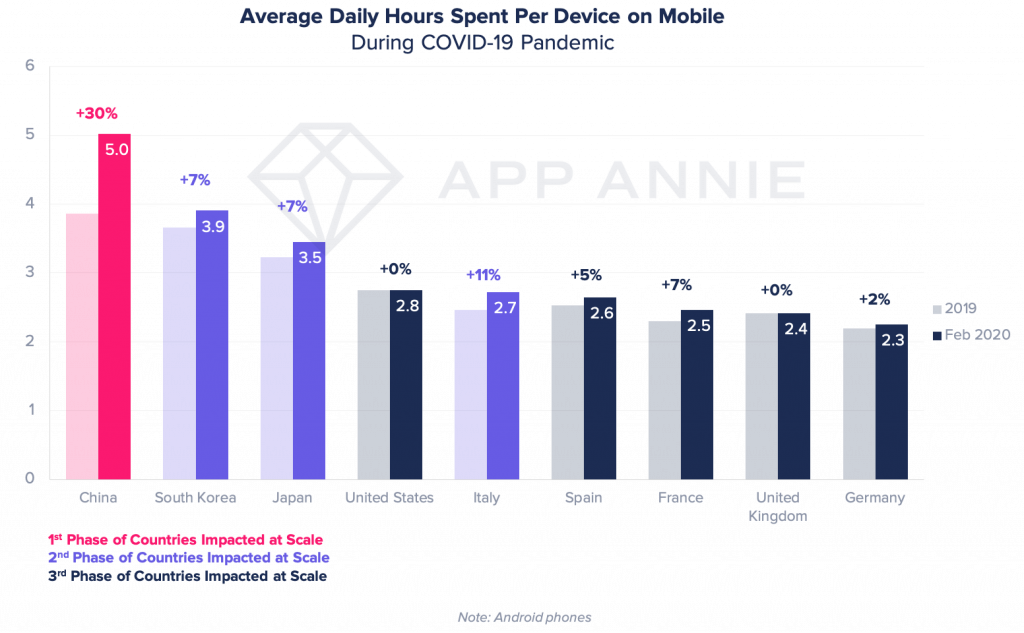
As we take a look at the impact of the coronavirus across key industries and how this is taking effect in phases in markets, one central thread emerges: people are leaning on mobile during this difficult time.
The First Front: Business and Education Apps
One of the first major movements we saw in the mobile economy was the surge of usage in Business apps in China. Following the closure of cities and the introduction of work from home and social distancing policies, we saw downloads and hours spent in Business apps take off.
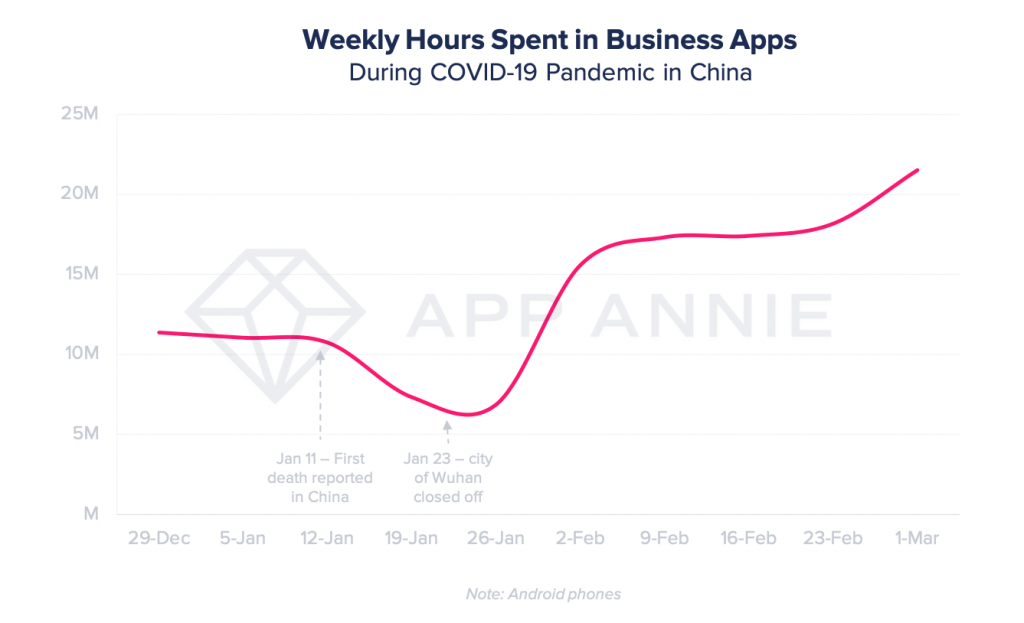
In fact, the week of Feb 2, 2020 was the biggest week ever in China in terms of iOS app downloads. Business and Education apps saw the biggest surge in downloads among categories of apps. During the first half of February 2020, Business and Education apps were downloaded at levels roughly 2x the weekly average in 2019. Popular apps during this time included HUAWEI CLOUD WeLink, DingTalk and ZOOM Cloud Meetings.
We saw a similar trend emerge in Italy. The number of coronavirus cases in Italy surged to 400 on February 26, 2020, and Italy became the focus of Europe with 11 towns entering quarantine. By March 7, 2020 over 4,600 cases had been reported. On March 9, 2020 Italy placed quarantine restrictions over the entire country. During the first week of March, 761,000 downloads of Business apps occurred across iOS and Google Play in Italy — marking the biggest week ever for the category. This was up 85{3c4481f38fc19dde56b7b1f4329b509c88239ba5565146922180ec5012de023f} from the week prior (the second highest week), and up 135{3c4481f38fc19dde56b7b1f4329b509c88239ba5565146922180ec5012de023f} from the average weekly level of the 52 weeks prior.
The same trend is starting to emerge in other markets as COVID-19 spreads. With many businesses in affected areas adopting work from home policies, we see workers turning to mobile apps to communicate, collaborate and teleconference to continue working without interruption. Globally, we’ve seen ZOOM Cloud Meetings top downloads charts across many markets.
As of March 16, 2020 ZOOM Cloud Meetings ranks #1 for overall iPhone app downloads (across all games and apps) in 35 markets, and #1 in among Business apps on iPhones in 90 markets.
Consumers Turn to Mobile Games to Stay Entertained
We have seen strong growth in downloads of Games in affected markets, as consumers turn to mobile to stay entertained and pass the time while under quarantine. As with Business apps, we saw this trend first surface in China. In February 2020, the average weekly game downloads in China went up 80{3c4481f38fc19dde56b7b1f4329b509c88239ba5565146922180ec5012de023f} compared to the average weekly download for the whole of 2019, with average weekly downloads of 63 Million on iOS App Store. This was up by 25{3c4481f38fc19dde56b7b1f4329b509c88239ba5565146922180ec5012de023f} compared to the average weekly downloads in the month of January 2020.
South Korea was another market hit early on by coronavirus. In the week starting 23rd of February 2020, the average weekly game downloads in South Korea were up 35{3c4481f38fc19dde56b7b1f4329b509c88239ba5565146922180ec5012de023f} compared to the 2019 weekly average, exceeding 15 Million downloads during that week. This was up by 25{3c4481f38fc19dde56b7b1f4329b509c88239ba5565146922180ec5012de023f} compared to the average weekly downloads in the month of January 2020.

As of March 16, 2020 there were over 182,000 confirmed cases of COVID-19 worldwide. We’ve seen the US and countries in Europe ramp up containment measures and social isolation policies. The CDC also recommended events with 50 or more guests be postponed for 8 weeks. San Francisco just enacted a “shelter in place” policy effective from March 17 to April 7. As more people face an increase in time indoors, they are turning to mobile to stay entertained. We expect more countries to follow the pattern in China and South Korea and see an increase in downloads of Games.
We’ve pulled the top 10 games by downloads to reflect the current demand during the first two weeks of March. Notably, Slap Kings, Woodturning, Draw Climber and Brain Test: Tricky Puzzles ranked in the top 10 games by downloads among many of the markets analyzed that are experiencing coronavirus outbreaks at scale.
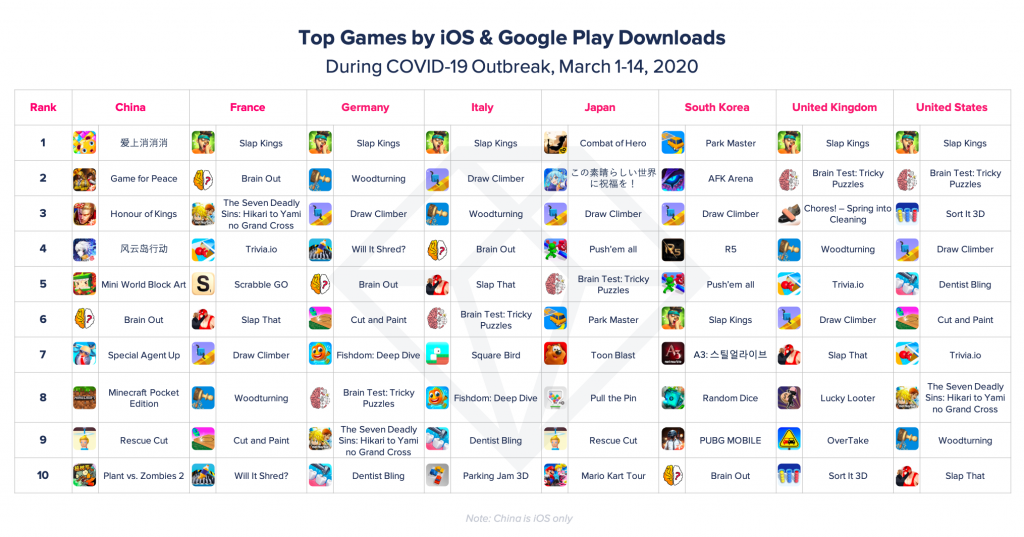
Social Media and Entertainment Apps Provide Connection and Pass the Time
Alongside gaming, we saw consumers turn to social media and video streaming apps to be entertained and keep in touch with loved ones while also keeping them safe. In China, TikTok saw a surge in average time spent per user as well as total time spent in the app on Android phones following the initial COVID-19 outbreak. TikTok is both a platform for passing the time by watching short looping videos and by creating these videos and social networking with others in efforts to attract viewers. In 2019, we saw 8 of every 10 minutes in TikTok come from users in China and time spent exceeded 68 billion hours worldwide. The week of March 1, 2020 was TikTok’s biggest week ever in China, with users spending over 3 billion hours in aggregate in the app — up 130{3c4481f38fc19dde56b7b1f4329b509c88239ba5565146922180ec5012de023f} from the weekly average in 2019. This was both a product of more users accessing the platform and those users spending more time in it on average.
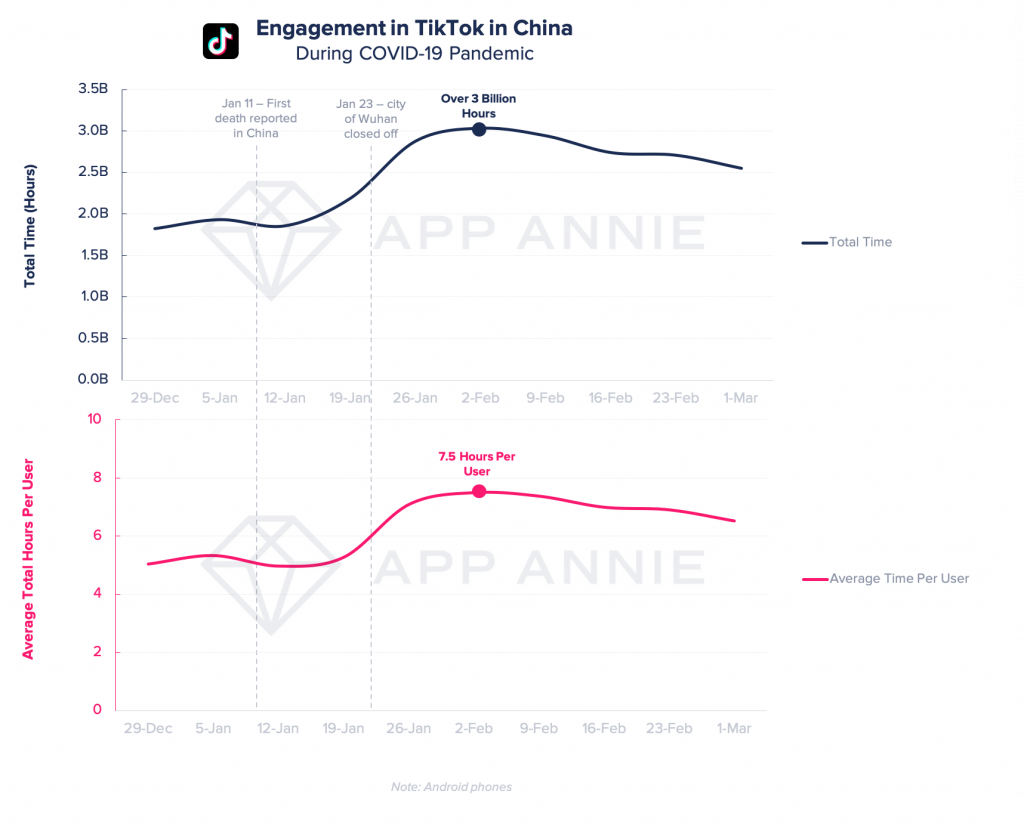
We also took a look at video streaming apps. While the time spent in the top 10 video streaming apps on Android phones in the US has not yet seen a meaningful uptick during the months of the coronavirus pandemic, hovering at an average of 405 million hours as of March 1-7, we did see a shift in the apps ranking among the top 10. Looking at the week of March 1, 2020 where the coronavirus outbreak and market, government and commercial response escalated, we saw 2 video streaming apps with rapid growth as they entered the top 10. This is an indication that consumers are looking outside their normal “go-to” streaming apps — expanding the catalogue of content they have available to them.
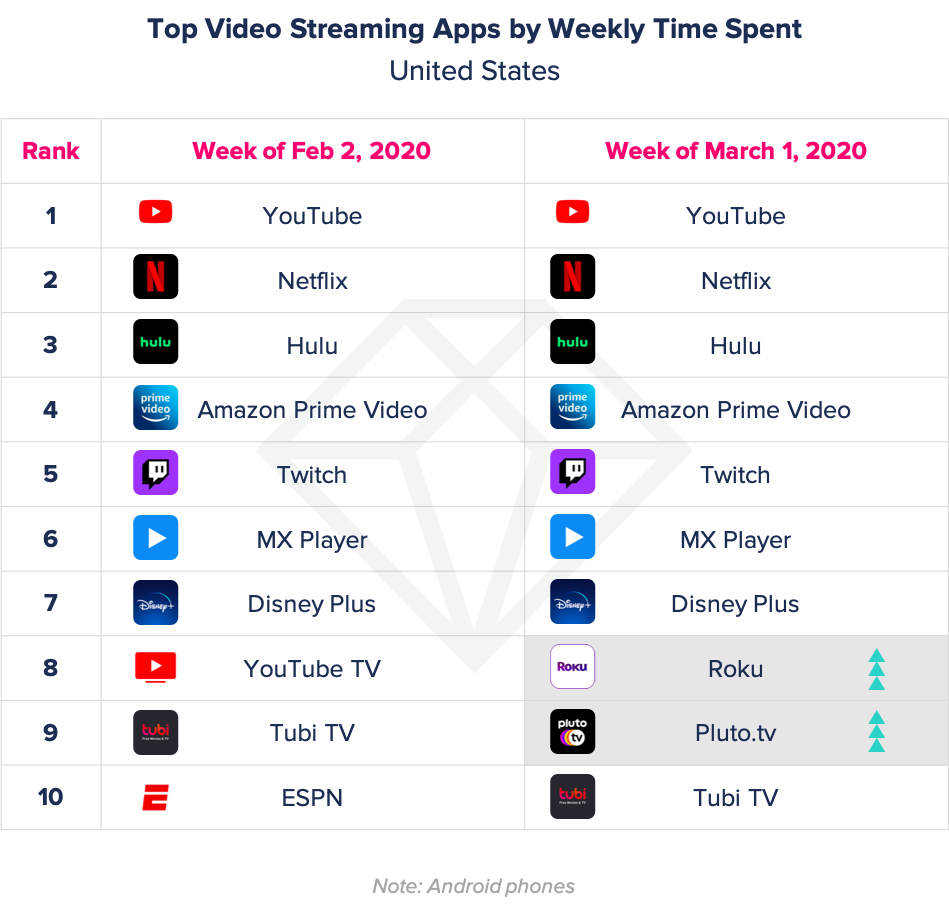
Noticeably, Roku and Pluto.tv were those new entrants to the top 10 video streaming apps by weekly time spent for the week of March 1, 2020 compared to 4 weeks prior. Roku’s app can be used both to stream content on your mobile device and to act as a control for your Roku player. Pluto.tv (and Tubi TV) is a completely free service, creating a low barrier to entry for consumers looking for additional content streams, whereas Netflix, Hulu, Amazon Prime Video and Disney+ all require subscriptions.
As Americans work from home mandates and social distancing policies take effect, they are turning to their mobile devices to pass the time by streaming new series and shows. One standout example is Pluto.tv — a free streaming app with no subscriptions. We’ve seen a strong increase in time spent in Pluto TV. During the week of March 1-7, 2020 time spent in Pluto increased 75{3c4481f38fc19dde56b7b1f4329b509c88239ba5565146922180ec5012de023f} week over week on Android phones in the US — the highest week ever for the app. In fact, time spent during this week was 2.5x the average weekly time spent throughout 2019 and 2020. This is a result both of a wider audience using the app as well as the average user spending more time in the app, and for video streaming apps this equates to streaming more content. Companies are adapting to this desire for more content from home during the coronavirus pandemic— movie theatres are releasing movies currently in theatres available to stream at home and Disney released Frozen II early on Disney+ and Rise of Skywalker early to digital rental.
With Increasing Coronavirus Cases, Consumers Shy From In-Person Contact and Demand for Ride-Sharing Apps Softens
Among markets analysed (US, UK, China, Japan, France and South Korea), the largest impact on downloads of top ride-sharing apps appeared in China and France. China saw weekly downloads of Didi fall 75{3c4481f38fc19dde56b7b1f4329b509c88239ba5565146922180ec5012de023f} from the highest week to its lowest week in the period analysed (Jan 29, 2019 through Mar 7, 2020). France saw weekly downloads of BlaBlaCar fall 65{3c4481f38fc19dde56b7b1f4329b509c88239ba5565146922180ec5012de023f} from the highest week to its lowest week in the period analysed (Jan 29, 2019 through Mar 7, 2020).
The UK and the US haven’t had a meaningful decline in weekly downloads of Uber during the period analysed. While KakaoTaxi and Japan Taxi have also seen a decline in weekly downloads in South Korea and Japan, respectively, the degree of drop off in their curves are not as dramatic as in France and China. Given travel restrictions in markets, and the closure of bars and restaurants this drop is not unexpected. We’ll look for a rebound in numbers when consumers begin venturing out again once containment measures bear positive metrics.
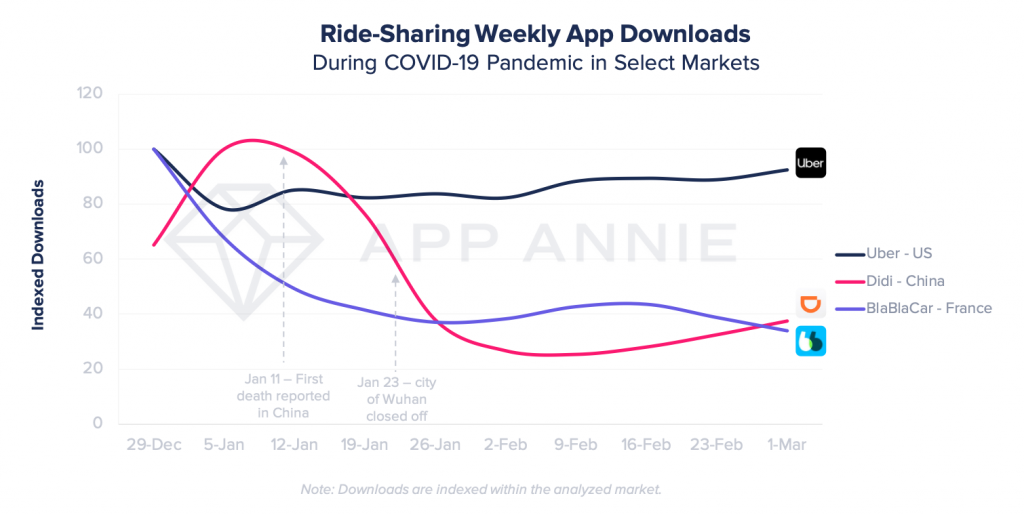
Social Distancing, Work From Home and Quarantine Policies Beget an Uptick in Demand for Food Delivery Apps
An increase in engagement for food and grocery delivery apps are a lagging indicator of the growth of coronavirus spread within a market, as this increase is expected to take effect after work from home and social distancing policies have been put into effect. This is typically after the cases of COVID-19 have reached a meaningful threshold in the respective market.
We took a look at Food and Drink apps in China, the UK, Japan, South Korea, Germany, Italy, the US, Spain and France and saw the strongest growth in total sessions in recent weeks in the US, Spain and France. France saw an uptick during the week of Feb 16, whereas Spain and the US saw strong growth in total sessions during the week of March 1. Each session indicates a reflection of potential demand for food whether this is researching restaurants, placing an order or checking the status of delivery. China also saw strong growth in weekly time spent in February and the first week of March, but still down from where we entered 2020. We expect to see an increase in food and grocery delivery apps as more city, state and federal governments impose mandatory quarantines and extend social distancing policies in the weeks to come.
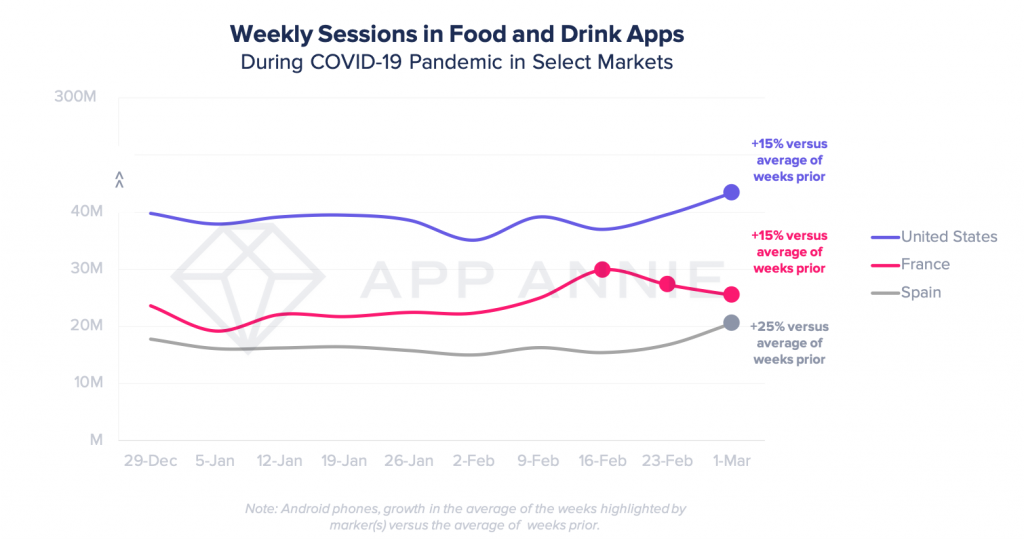
Amidst Market Uncertainty, Consumers Turn to FinTech Apps
We’ve already seen the economic instability play out in the stock market as the coronavirus pandemic spread across countries and its effects were felt across industries. In tandem with a drop in oil prices, consumers are concerned about the state of the global economy as we battle the pandemic that faces us. This concern is reflected in an increase in the average weekly hours spent in Finance apps across markets. Japan, South Korea, the US and China saw the biggest uptick in time spent during the first week of March, compared to the last week of 2019 at 55{3c4481f38fc19dde56b7b1f4329b509c88239ba5565146922180ec5012de023f}, 35{3c4481f38fc19dde56b7b1f4329b509c88239ba5565146922180ec5012de023f}, 20{3c4481f38fc19dde56b7b1f4329b509c88239ba5565146922180ec5012de023f} and 20{3c4481f38fc19dde56b7b1f4329b509c88239ba5565146922180ec5012de023f} respectively.

In the US, demand increased for Robinhood, a FinTech app that has democratised investing, has seen 50{3c4481f38fc19dde56b7b1f4329b509c88239ba5565146922180ec5012de023f} growth in iOS and Google Play downloads during the first half of March compared to the two weeks prior. In Japan, weekly time spent on Android phones in FinTech app au PAY grew 20{3c4481f38fc19dde56b7b1f4329b509c88239ba5565146922180ec5012de023f} week over week in the first week of March. During the same time period, FinTech app PASS by SK TELECOM(구, T인증) in South Korea also grew 20{3c4481f38fc19dde56b7b1f4329b509c88239ba5565146922180ec5012de023f} in weekly time spent.
Consumers Turn to Mental Health and Telemedicine Apps to Manage Stress and Flatten the Curve
We’ve seen the average weekly time spent in Health and Fitness and Medical apps increase significantly through the week of March 1, 2020 on Android phones in the US. Headspace — a meditation and mindfulness app — has seen a 90{3c4481f38fc19dde56b7b1f4329b509c88239ba5565146922180ec5012de023f} increase in time spent on iPhones in the US during the week of March 1st week over week. As work from home and social isolation policies are put in place, consumers are turning to mobile to find peace of mind and manage stress. During the same time frame, we’ve also seen a 200{3c4481f38fc19dde56b7b1f4329b509c88239ba5565146922180ec5012de023f} increase in time spent in the Mayo Clinic app on Android phones in the US week over week. The app provides users access to appointment scheduling, secure messaging with health care professionals, information on symptoms and diseases and viewing test results.
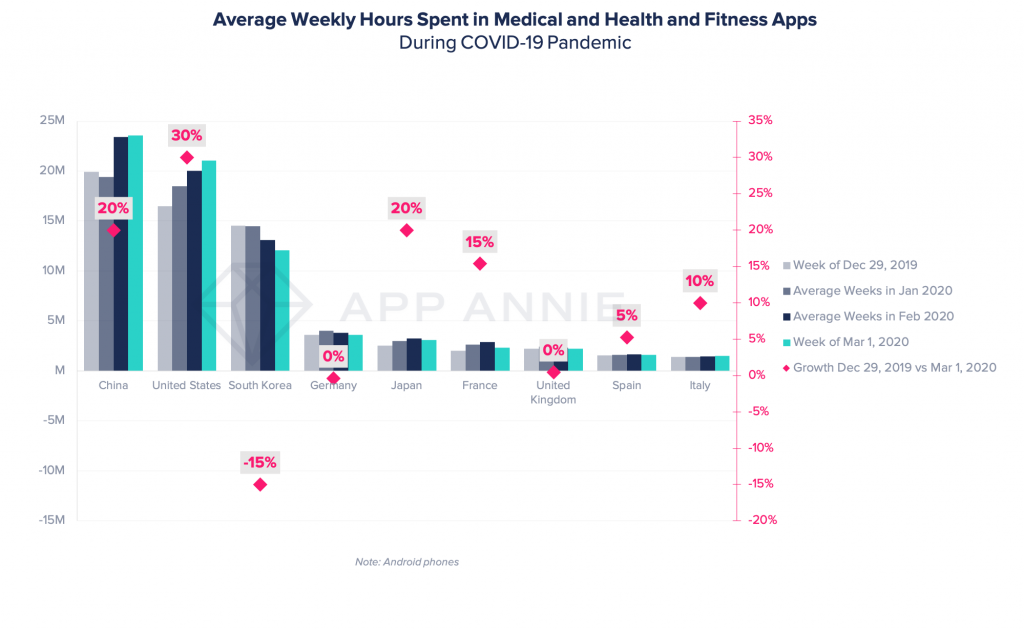
In China, we have seen strong growth in hours spent in Medical and Health and Fitness apps throughout February and the first week of March. Keep, an exercise app, saw an increase of 210{3c4481f38fc19dde56b7b1f4329b509c88239ba5565146922180ec5012de023f} in time spent in February 2020, month over month, as people in quarantine sought to stay active despite confinement. Japan has also seen strong growth in usage of Medical and Health and Fitness apps. ITICKET, a medical appointment-booking app, saw 50{3c4481f38fc19dde56b7b1f4329b509c88239ba5565146922180ec5012de023f} growth in total time spent on Android phones in Japan during the week of March 1st.
Gamification of Dating Apps Could Help Keep Users Engaged as In-Person Contact Lessons in Coming Weeks
We have seen a softening in active users among the top dating apps in the US in the weeks post-Valentine’s Day, but it’s important to note that we typically see a peak in usage surrounding Valentine’s Day followed by a slight softening in the weeks after, which is in-line with what we saw this year. Some of this could be attributed to an impact from the coronavirus, but given the current pattern aligns with typical seasonality, we will need to monitor the weeks to come to assess the real impact of the coronavirus on usage.
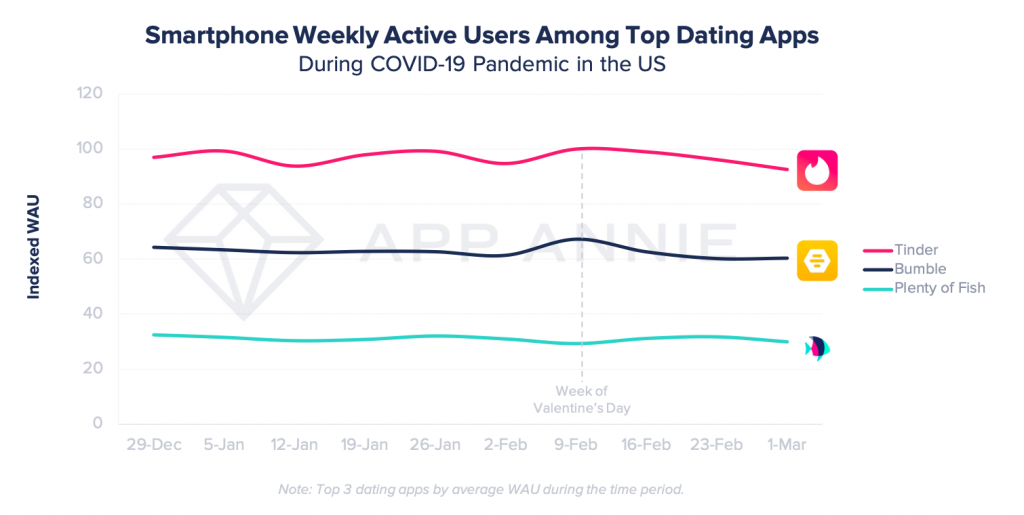
Within dating apps, users can still be active by matching and messaging without actually meeting up in-person. This is different to industries like ride-sharing where use of the app typically begets an in-person interaction. As a result, we have seen a weakening in demand for top ride-sharing apps in recent weeks in countries with large outbreaks like China and France. However, we have not seen this take effect yet in the US, but could in the coming weeks as local, state and federal governments ramp up social distancing measures and travel restrictions. We’ve also seen an increase in mobile games downloads and usage of top social apps — an indication that consumers are turning to mobile to stay entertained while they are required to remain indoors during city shutdowns and work from home policies. The gamification of “swiping” in dating apps slots into this behavior to find avenues to pass time and entertain, so we could expect to see a level of resiliency there.
Looking Forward, Changes in Mobile Will Reflect Our Preferences as We Weather This Storm
Mobile is a reflection of our lives — what is important to us in that moment, what is helping us get through the day, and what is connecting us to other people and the world at large. It allows us to get the information and services we need in stressful times right at our fingertips — whether that is the ability to continue working, distraction and entertainment or knowledge on how to do our part and stay healthy, informed global citizens.
We expect coronavirus’s influence to surface through our mobile actions for the weeks to come. As more countries and businesses take precautionary measures to flatten the curve of COVID-19, consumers stay home and self-isolate, we expect to see novel consumer behaviour emerge in nearly every industry.

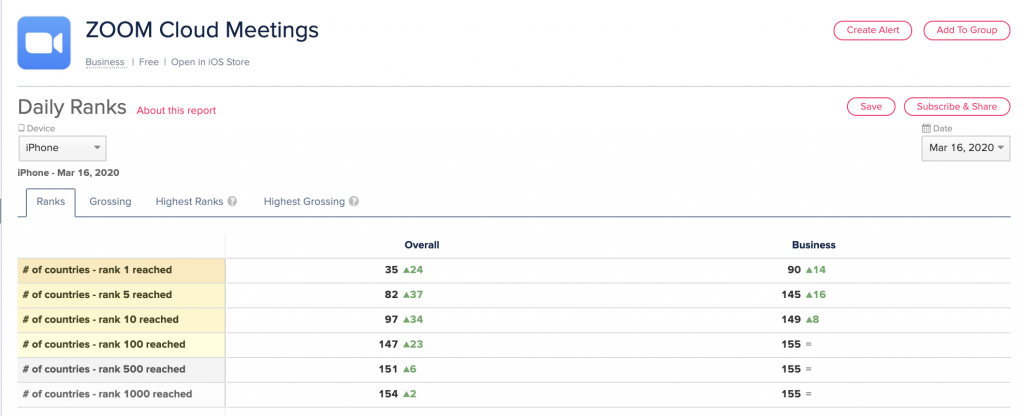




More Stories
Acceptance of Credit Cards Without a Merchant Account
Maximize Your Medisoft! (Unknown and Underused Functions of Medisoft)
Learning About the Reverse Mortgage Option